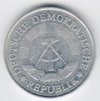East German mark
|
|
The East German mark (German language: Mark der DDR), commonly called Ostmark, "Eastern mark", was the currency of East Germany.
Officially it was known as the Mark der DDR (Mark of the GDR) and colloquially it was just known as the Mark. It was divided into 100 pfennigs (Pf). Coins were of 1, 5, 10, 20 and 50 pfennigs, as well as 1 and 2 marks. Bills were of 5, 10, 20, 50, and 100 marks. Later on, 200 and 500 mark bills were printed, but were never issued, as the government believed they would make the country appear to have inflationary tendencies.
It was replaced by Deutsche Marks on 1 July 1990 (currency union with the Federal Republic of Germany). It could not be spent in intershops to acquire Western consumer goods, instead hard currencies or forum checks had to be used there.
It was officially valued by the East German government at parity with the Deutsche Mark, but it was never freely convertible. Visitors to East Germany were required to exchange Deutsche Marks with Ostmarks at this ratio. In the black market this rate was about 5 to 10 Ms for a DM.
1975-DDR-100.jpg
Upon adoption of the Deutsche Mark in East Germany, it was converted at 1:1 for wages, prices, and basic savings. Larger amounts were converted at a 1:2 rate. This inflated exchange rate was intended as a massive subisidy for eastern Germany by government of the Federal Republic of Germany, and remains controversial among economists, with some arguing that the exchange of currency was the most practical way of quickly unifying the German economy, and others arguing that the exchange increased the disruption of German unification beyond what they otherwise would be, by among other things, making eastern German industries uncompetitive.de:Mark der DDR ko:동독 마르크 ja:東ドイツマルク sv:Ostmark


